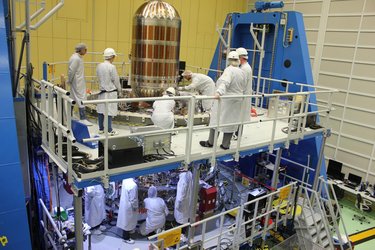Accept all cookies Accept only essential cookies See our Cookie Notice

About ESA
The European Space Agency (ESA) is Europe’s gateway to space. Its mission is to shape the development of Europe’s space capability and ensure that investment in space continues to deliver benefits to the citizens of Europe and the world.
Highlights
ESA - United space in Europe
This is ESA ESA facts Member States & Cooperating States Funding Director General Top management For Member State Delegations European vision European Space Policy ESA & EU Space Councils Responsibility & Sustainability Annual Report Calendar of meetings Corporate newsEstablishments & sites
ESA Headquarters ESA ESTEC ESA ESOC ESA ESRIN ESA EAC ESA ESAC Europe's Spaceport ESA ESEC ESA ECSAT Brussels Office Washington OfficeWorking with ESA
Business with ESA ESA Commercialisation Gateway Law at ESA Careers Cyber resilience at ESA IT at ESA Newsroom Partnerships Merchandising Licence Education Open Space Innovation Platform Integrity and Reporting Administrative Tribunal Health and SafetyMore about ESA
History ESA Historical Archives Exhibitions Publications Art & Culture ESA Merchandise Kids Diversity ESA Brand CentreLatest
Space in Member States
Find out more about space activities in our 23 Member States, and understand how ESA works together with their national agencies, institutions and organisations.
Science & Exploration
Exploring our Solar System and unlocking the secrets of the Universe
Go to topicAstronauts
Missions
Juice Euclid Webb Solar Orbiter BepiColombo Gaia ExoMars Cheops Exoplanet missions More missionsActivities
International Space Station Orion service module Gateway Concordia Caves & Pangaea BenefitsLatest
Space Safety
Protecting life and infrastructure on Earth and in orbit
Go to topicAsteroids
Asteroids and Planetary Defence Asteroid danger explained Flyeye telescope: asteroid detection Hera mission: asteroid deflection Near-Earth Object Coordination CentreSpace junk
About space debris Space debris by the numbers Space Environment Report In space refuelling, refurbishing and removingSafety from space
Clean Space ecodesign Zero Debris Technologies Space for Earth Supporting Sustainable DevelopmentLatest
Applications
Using space to benefit citizens and meet future challenges on Earth
Go to topicObserving the Earth
Observing the Earth Future EO Copernicus Meteorology Space for our climate Satellite missionsCommercialisation
ESA Commercialisation Gateway Open Space Innovation Platform Business Incubation ESA Space SolutionsLatest
Enabling & Support
Making space accessible and developing the technologies for the future
Go to topicBuilding missions
Space Engineering and Technology Test centre Laboratories Concurrent Design Facility Preparing for the future Shaping the Future Discovery and Preparation Advanced Concepts TeamSpace transportation
Space Transportation Ariane Vega Space Rider Future space transportation Boost! Europe's Spaceport Launches from Europe's Spaceport from 2012Latest

Ready for Moon delivery
Thank you for liking
You have already liked this page, you can only like it once!
Engineers and technicians keep a close eye on the third European Service Module (ESM-3) leaving the integration hall at Airbus Defence and Space in Bremen, Germany. It is a bittersweet moment for the teams that have been working on it for years – it is the last time they will see the module in Europe before it flies to the Moon.
This powerhouse, boasting 33 engines, will propel humans to the Moon during NASA’s Artemis III mission. The crew will travel on the Orion spacecraft, pictured on the wall to the right of the image with all its components assembled. ESM-3 is designed to provide propulsion, electrical power and life support for astronauts.
The European module is a marvel of engineering, comprising over 22 000 parts and weighing around 13 tonnes. ESM-3 was built with contributions from over 20 companies across more than 10 European countries.
The third in the series embarked on a voyage across the Atlantic Ocean aboard the Canopée transport ship. Its destination is NASA’s Kennedy Space Center in Florida, USA, where the teams will connect it with the Orion crew module, install its seven-metre-long solar arrays, and run final tests in preparation for launch.
Unlike the Apollo missions, which used fuel cells to generate electricity, Orion uses solar arrays. The four solar array wings can provide enough electricity to power two households with four tenants on Earth. The main engine is a repurposed orbital manoeuvring system engine (OMS-E) with nine Space Shuttle missions under its belt. This legendary, powerful machine provides enough thrust to escape Earth’s gravitational field and perform the translunar injection burn to get into the Moon’s orbit.
For the latest updates, follow the journey on ESA’s Orion blog and X.
-
CREDIT
ESA-P. Sebirot -
LICENCE
ESA Standard Licence

ESM-2 ready for delivery

European Service Module ready for shipping

Orion service module fuel tank

Orion service module fuel tank installation















 Germany
Germany
 Austria
Austria
 Belgium
Belgium
 Denmark
Denmark
 Spain
Spain
 Estonia
Estonia
 Finland
Finland
 France
France
 Greece
Greece
 Hungary
Hungary
 Ireland
Ireland
 Italy
Italy
 Luxembourg
Luxembourg
 Norway
Norway
 The Netherlands
The Netherlands
 Poland
Poland
 Portugal
Portugal
 Czechia
Czechia
 Romania
Romania
 United Kingdom
United Kingdom
 Slovenia
Slovenia
 Sweden
Sweden
 Switzerland
Switzerland






















